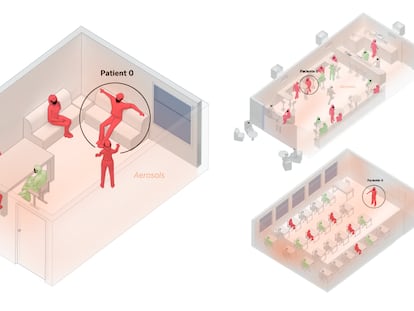Covid-19 outbreak in California: What is happening in the state?
The rise in Covid infections in the United States is attributed to a new dominant strain called KP.3. This variant belongs to the group known as FLiRT, which also includes the KP.2 and KP.1.1 variants

Over the past few weeks, Google searches for the term FLiRT have increased by 98%. The spike in interest is due to the fact that SARS-CoV-2 — the virus that causes Covid-19 — continues to mutate. In April, a group of new viral strains called FLiRT variants was identified.
The term FLiRT comes from the technical names for their mutations. “This is the term being used to describe a whole family of different variants — including KP.2, JN.1.7, and any other variants starting with KP or JN — that appear to have independently picked up the same set of mutations,” explains the Johns Hopkins University.
According to an article from Yale University, to better understand how the FLiRT strains emerged, it is useful to “see how the SARS-CoV-2 virus has changed over time, with new variants forming as mutations emerged in its genetic code.” The article explains that the Omicron variant of SARS-CoV-2, which took hold in the United States in 2021, gave rise to various subvariants, including JN.1, which was identified in September 2023.
FLiRT variants have become a significant concern in the United States due to their ability to spread rapidly and evade acquired immunity, both from previous infections and vaccines. Indeed, the variants are of such great concern, the Centers for Disease Control and Prevention (CDC) is now closely monitoring them.
What is the KP.3 variant?
The KP.3 variant comes from JN.1.11.1, a direct descendant of JN.1. The main concerns over the KP.3 variant are due to its genetic mutations, especially in the spike protein, which is crucial for the virus’ entry into human cells. These genetic mutations have led to a rapid increase in Covid-19 cases in densely populated regions, with California one of the most affected states in the United States.
Johns Hopkins University reported: “At the end of March, the KP.2 variant was causing about 4% of infections in the U.S., according to the CDC, while its parental strain, JN.1, was causing over 50% of infections at that time. As of early May, KP.2 makes up about 28% of infections, overtaking JN.1 as the dominant variant.” Now KP.3 is gaining ground.
Based on estimates from California Department of Public Health model, KP.3 is expected to be the dominant variant (41.9%).
Who can be affected by the new variants of Covid-19?
People of different ages in the U.S. have been affected by the recorded Covid-19 cases due to the KP.3 variant. Some specialists say that, even if a person has had JN.1, they can become infected with the KP.3 variant, especially if their last infection with Covid-19 occurred several months ago.
What are the symptoms of the new strain?
At this time, common symptoms of the new Covid-19 KP.3 and other variants of the FLiRT strain are:
- Nasal congestion
- Sore throat
- Fatigue
- Headache
- Cough
- Muscle or body pain
- Fever or chills
- Nausea or vomiting
- Diarrhea
- Loss of taste or smell
- Shortness of breath or difficulty breathing
What precautions can be taken to avoid becoming infected?
California’s Department of Public Health continues to recommend vaccination as the primary strategy to reduce the risk of severe illness, hospitalization, and death from Covid-19. But there are other easy measures to follow too:
- Get vaccinated against Covid and stay up to date with vaccines
- Use disposable “surgical” masks, preferably N95 or KN95
- Wash your hands often with soap and water for at least 20 seconds, especially if you have been in a public place
- Use a hand sanitizer with at least 60% alcohol
- Cover your mouth and nose when coughing and sneezing
- Practice social distancing by staying at least two meters away from other people
- Avoid crowded closed places and closed spaces with poor ventilation
- Avoid direct contact with people who have Covid-19
- Regularly clean and disinfect frequently touched surfaces, especially if a family member has had a positive PCR or antigen test result or is sick
Sign up for our weekly newsletter to get more English-language news coverage from EL PAÍS USA Edition
Tu suscripción se está usando en otro dispositivo
¿Quieres añadir otro usuario a tu suscripción?
Si continúas leyendo en este dispositivo, no se podrá leer en el otro.
FlechaTu suscripción se está usando en otro dispositivo y solo puedes acceder a EL PAÍS desde un dispositivo a la vez.
Si quieres compartir tu cuenta, cambia tu suscripción a la modalidad Premium, así podrás añadir otro usuario. Cada uno accederá con su propia cuenta de email, lo que os permitirá personalizar vuestra experiencia en EL PAÍS.
¿Tienes una suscripción de empresa? Accede aquí para contratar más cuentas.
En el caso de no saber quién está usando tu cuenta, te recomendamos cambiar tu contraseña aquí.
Si decides continuar compartiendo tu cuenta, este mensaje se mostrará en tu dispositivo y en el de la otra persona que está usando tu cuenta de forma indefinida, afectando a tu experiencia de lectura. Puedes consultar aquí los términos y condiciones de la suscripción digital.
More information
Archived In
Últimas noticias
Most viewed
- Reinhard Genzel, Nobel laureate in physics: ‘One-minute videos will never give you the truth’
- Oona Chaplin: ‘I told James Cameron that I was living in a treehouse and starting a permaculture project with a friend’
- Pablo Escobar’s hippos: A serious environmental problem, 40 years on
- Why we lost the habit of sleeping in two segments and how that changed our sense of time
- Charles Dubouloz, mountaineering star, retires at 36 with a farewell tour inspired by Walter Bonatti











































